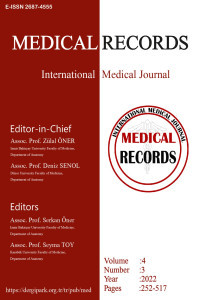Lomber Disk Hernili Hastalarda Q açısı ve Hamstring Uzunluğunun Denge Performansına Etkisi
Lumbar intervertebral disc herniation, Patellafemoral angle, Hamstring length, Y balance test
The effects of Q angle and Hamstring Length on Balance Performance in Patients with Lumbar Disc Hernia
Lumbar intervertebral disc herniation, Patellafemoral angle, Hamstring length, Y balance test,
___
- 1. Abramovitz JN, Neff SR. Lumbar disc surgery: results of the prospective lumbar discectomy study of the joint section on disorders of the spine and peripheral nerves of the American Association of Neurological Surgeons and the Congress of Neurological Surgeons. Neurosurgery. 1991;29:301-8.
- 2. Atlas SJ, Deyo RA, Keller RB, et al. The maine lumbar spine study, part II: 1-year outcomes of surgical and nonsurgical management of sciatica. Spine (Phila Pa 1976). 1996;21:1777-86.
- 3. Modic MT, Ross JS. Lumbar degenerative disk disease. Radiology. 2007;245:43-61.
- 4. Waris E, Eskelin M, Hermunen H, et al. Disc degeneration in low back pain: a 17-year follow-up study using magnetic resonance imaging. Spine (Phila Pa 1976). 2007;32:681-4.
- 5. Karvonen MJ, Viitasalo JT, Komi PV, et al. Back and leg complaints in relation to muscle strength in young men. Scand J Rehabil Med. 1980;12:53-9.
- 6. Şenol D, Altinoğlu M, Toy Ş, et al. Investigation of the relationship of Q Angle and stork balance stand test with somatotype in healthy young individuals. Medical Records. 2019;1:60-6.
- 7. Citaker S, Kaya D, Yuksel I, et al. Static balance in patients with patellofemoral pain syndrome. Sports Health. 2011;3:524-7.
- 8. Lihavainen K, Sipilä S, Rantanen T, et al. Contribution of musculoskeletal pain to postural balance in community-dwelling people aged 75 years and older. J Gerontol A Biol Sci Med Sci. 2010;65:990-6.
- 9. Halperin N, Copeliovitch L, Schachner E. Radiating leg pain and positive straight leg raising in spondylolysis in children. J Pediatr Orthop. 1983;3:486-90.
- 10. Bohannon R, Gajdosik R, LeVeau BF. Contribution of pelvic and lower limb motion to increases in the angle of passive straight leg raising. Physical Therapy. 1985;65:474-6.
- 11. Yilmaz A, Kabadayi M, Mayda M, et al. Analysis of Q angle values of female athletes from different branches. Sci Mov Heal. 2017;17:141-6.
- 12. Baumgartner RN, Chumlea C, Roche AF. Bioelectric impedance for body composition. Exerc Sport Sci Rev. 1990;18:193-224.
- 13. ELİÖZ M, Tülin A, Ajlan S, YAMAK B. The investigion of the relatonship between some physicial features with Q angle in athletes and sedanteries. Spor ve Performans Araştırmaları Dergisi. 2015;6:58-65.
- 14. Akınoğlu B, Paköz B, Hasanoğlu A, Kocahan T. Investigation of the relationship between sit-and-reach flexibility and the height, the leg length and the trunk length in adolescent athletes. Balt J Health Phys Act. 2021;13:29-37.
- 15. Hertel J, Miller SJ, Denegar CR. Intratester and intertester reliability during the star excursion balance tests. Journal of Sport Rehabilitation. 2000;9:104-16.
- 16. Coughlan GF, Fullam K, Delahunt E, et al. A comparison between performance on selected directions of the star excursion balance test and the Y balance test. J Athl Train. 2012;47:366-71.
- 17. Akman MN, Karataş M. Temel ve uygulanan kinezyoloji. In: Kinezyoloji. Haberal Eğitim Vakfı. 1th, Rize, 2003;123-8.
- 18. Almeida GPL, França FJR, Magalhães MO, et al. Q-angle in patellofemoral pain: relationship with dynamic knee valgus, hip abductor torque, pain and function. Rev Bras Ortop. 2016;51:181-6.
- 19. Jeon H, Lee S-U, Lim J-Y, et al. Low skeletal muscle mass and radiographic osteoarthritis in knee, hip, and lumbar spine: A cross-sectional study. Aging Clin Exp Res. 2019;31:1557-62.
- 20. Bayraktar B, Yucesir I, Ozturk A, et al. Change of quadriceps angle values with age and activity. Saudi Med J. 2004;25:756-60.
- 21. Schulthies SS, Francis RS, Fisher AG, Van De Graaff KM. Does the Q angle reflect the force on the patella in the frontal plane? Phys Ther. 1995;75:24-30.
- 22. Karabulut M. Evaluation of the Relationship among radiological grading with q angle, femoral cartilage thickness and clinical parameters in patients with the knee osteoarthritis. Master thesis, Bursa Uludag University Bursa, 2018.
- 23. Oken O, Koybasi M, Tuncbilek I, Ayhan F, Yorgancioglu RZ. The association of presacral nodules with biomechanics of the lumbar region and lumbar discopaties in patients with low back pain. Turk J Phys Med Rehab. 2010:56:18-21.
- 24. Norris CM. Back stability: Human Kinetics Publishers. In: Scope of the Problem. 2nd edition. CRC Press, United Kingdom, 2000;317-22.
- 25. Kroll PG, Raya MA. Hamstring muscles: an overview of anatomy, biomechanics and function, injury etiology, treatment, and prevention. Critical Reviews in Physical and Rehabilitation Medicine. 1997;9:191-203.
- 26. Shin G, Shu Y, Li Z, Jiang Z, Mirka G. Influence of knee angle and individual flexibility on the flexion–relaxation response of the low back musculature. J Electromyogr Kinesiol. 2004;14:485-94.
- 27. Muyor JM, López-Miñarro PA, Casimiro AJ. Effect of stretching program in an industrial workplace on hamstring flexibility and sagittal spinal posture of adult women workers: a randomized controlled trial. JJ Back Musculoskelet Rehabil. 2012;25:161-9.
- 28. Carregaro RL, Coury HJCG. Does reduced hamstring flexibility affect trunk and pelvic movement strategies during manual handling? International Journal of Industrial Ergonomics. 2009;39:115-20.
- Yayın Aralığı: Yılda 3 Sayı
- Başlangıç: 2019
- Yayıncı: Zülal ÖNER
Lomber Disk Hernili Hastalarda Q açısı ve Hamstring Uzunluğunun Denge Performansına Etkisi
Selim ÇINAROĞLU, Hasan AKKAYA, Hacı KELEŞ, Fatih ÇİÇEK
Mahmut Zabit KARA, Mehmet Hamdi ÖRÜM, Ayşe Sevgi KARADAĞ, Aysun KALENDEROĞLU
Anıl ALTIPARMAK, Muhammed Furkan ARPACI, Merve AYDIN, Feyza İNCEOĞLU, Hıdır PEKMEZ
Hüseyin ERDEM, Mustafa TEKELİ, Yiğit ÇEVİK, Nazire KILIÇ ŞAFAK, Ömer KAYA, Neslihan BOYAN, Özkan OĞUZ
Ahmet YABALAK, Muhammed Nur ÖĞÜN
Evaluation of Poisoning Cases Presenting to the Pediatric Emergency Department
İlknur KABA, Samet Can DEMİRBAŞ, Havva Nur Peltek KENDİRCİ
Second Allogeneic Stem Cell Transplantation in Acute Leukemia with Post-Transplantation Relapse
Zeynep Tuğba GÜVEN, Serhat ÇELİK, Bülent ESER, Mustafa ÇETİN, Ali ÜNAL, Leylagül KAYNAR
Tuba OZCAN METİN, Gulsen BAYRAK, Selma YAMAN, Adem DOĞANER, Atila YOLDAŞ, Nadire ESER, Duygun ALTINTAŞ AYKAN, Banu YILMAZ, Akif Hakan KURT, Mehmet ŞAHİN, Gulsah GURBUZ
MATERNAL BISPHENOL-A'NIN SIÇAN BÖBREK GELİŞİMİ ÜZERİNDEKİ ETKİSİNİN İNCELENMESİ
